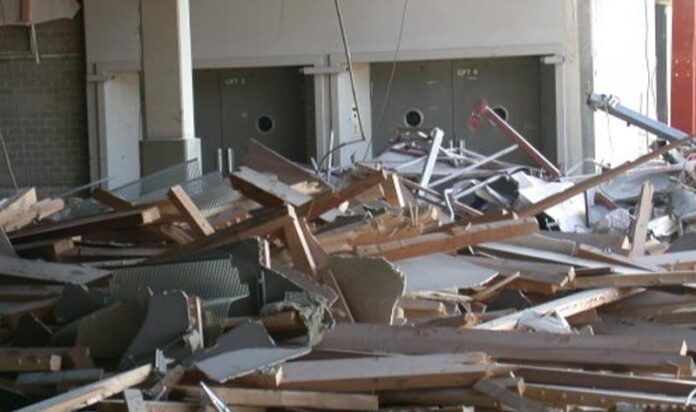If you want to compete with the new generation of modular manufacturers, then you must eliminate waste. Otherwise, don’t expect to be in business very long.
by Gary Fleisher
- Young owners in the offsite world are building aggressive lean operations
- Old equipment, processes and software will make you unable to compete
- Some examples of legacy systems and process that should be discarded
[Photo of Debris Pile]
We’ve all heard the expression: “One man’s treasure is another man’s trash.” It comes to mind when families clean out their parents’ homes after they pass away.
The things the parents wanted to save for their children, such as Grandma’s assorted plates, the silver-plated tea service, picture albums, flatware and favorite chairs, are unceremoniously either thrown in the dumpster or set aside for the infamous estate sale that always seems to follow the last parent’s death. The children see all this as trash and have no qualms about throwing it out.
Long-established modular factories are like those parents. Most want to hold on to things they believe are treasures that help their business. But the truth is that no one is going to want them.
If the factory were suddenly sold to an outside investor, all those treasures would immediately become suspect. I can see the new owners walking through the factory with an entirely different set of eyes.
It doesn’t matter if those eyes are veterans of modular manufacturing or brand new to it—they will tear into the trash the former owners left behind.
The first treasure to be thrown on the trash heap will be all the materials that have overgrown the warehouse space. That includes those 40 cabinets with missing doors, the remains of that special order material the inventory control person said to keep, he carriers in the yards with broken rails and missing wheels and axles with weeds and trees growing through them. And, of course, the third production line that was abandoned in 2008 but is still taking up space.
That’s just the obvious stuff. Next, the new owners will begin looking at the production line. If they had enough money to buy the factory, rest assured, they will be throwing outdated and unused equipment in the trash.
Then they will analyze every procedure at every station on the assembly line and ask why each is done the way it is, and what can be dumped, saved or reinvented.
Next, will be the systems used by the Sales Manager, the Production Manager, the Service Department and everyone else. Any outdated systems will be thrown onto the heap to be burned.
Finally, they will begin sorting through the biggest potential pile of trash they bought…the people.
The only two people always safe after purchase by an outside buyer are the receptionist and the CFO. The receptionist position in most factories is not a career choice and the turnover rate is fairly high, so it doesn’t make much sense to get rid of them. Besides, the receptionist is the only one who knows where people hide when the phone rings.
The CFO is safe for at least a couple of months. The new owners need to know who gets paid, who owes them money and where the treasure is buried.
Other than these two and the production line staff and workers, over the next short period of time look for everyone else to have their heads put on the chopping block. Even the company’s top salespeople may be sacrificed; at least those that didn’t jump ship to go to another factory and take their builders with them. New owners rarely want to keep the status quo and will likely recruit their own top performers.
Expect the new owners to be young techs armed with millions in investment money, with new ideas spilling from their heads on a daily basis. The days of a group of upper management people getting together and buying their factory are probably over. Today, it takes so much money to buy an existing factory or start a new one that the game has become about securing investors. Ultimately, the investors will ultimately control what happens at the factory.
It’s time for the shiny penny to replace the old worn-out one.
What if you have no intention of selling your modular home factory? Then throwing out the trash just might be what is required to stay in business. There are plenty of people skilled in modular efficiency ready to help you take out the trash and begin bringing in new procedures and people to, once again, make your modular home factory that bright new shiny penny.
Don’t put it off for too long or the next call just may be from that young woman with a high-tech background and $40 million dollars looking to either buy your factory cheap, or start building one next to you.
Gary Fleisher is Editor-in-Chief at iMediaGroup







